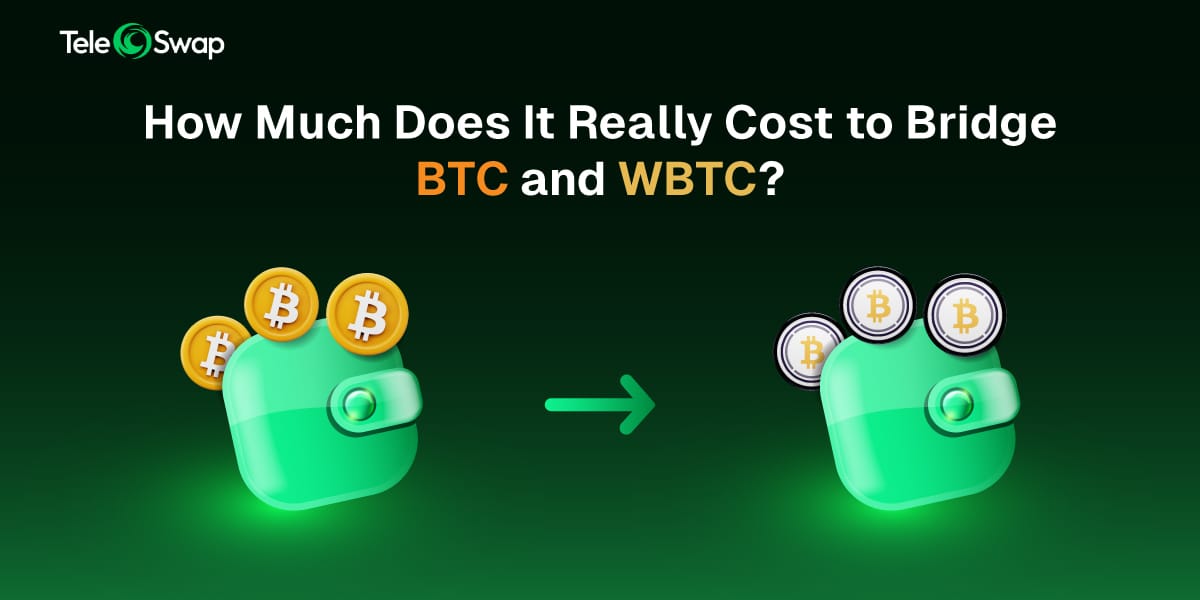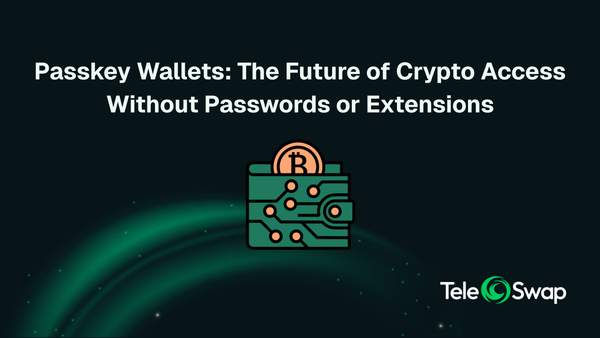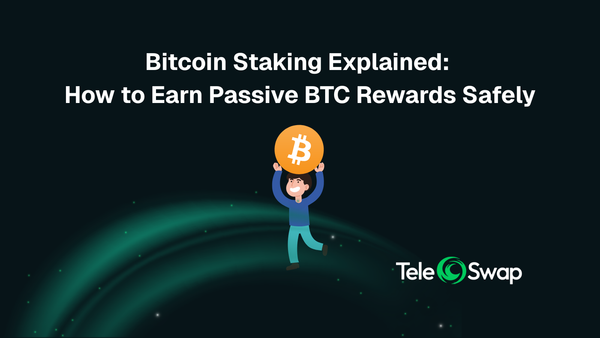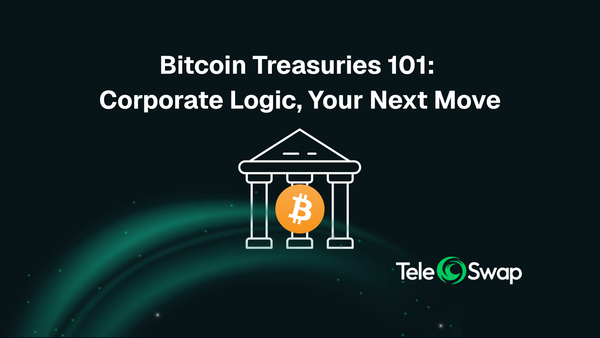How Much Does It Really Cost to Bridge BTC and WBTC? (2025 Guide)

Bridging Bitcoin (BTC) and Wrapped Bitcoin (WBTC) can unlock new possibilities, but it isn’t free. In this post, we’ll break down the real costs of moving between BTC and WBTC, your popular platforms, and uncover, hidden fees. You’ll learn how different methods (TeleSwap, THORChain, Binance/Coinbase, etc.) stack up, what “bridge fees” actually include, and how to minimize your pay. By the end, you’ll see why a solution like TeleSwap’s trustless 0.1% bridge can save you money and hassle when converting BTC↔WBTC.
BTC vs WBTC: Why Bridge Between Them?
Bitcoin (BTC) is the original cryptocurrency running on its blockchain. Wrapped Bitcoin (WBTC) is an ERC-20 token on Ethereum that’s pegged 1:1 to BTC. In simple terms, each WBTC represents one Bitcoin held in reserve, allowing BTC’s value to be used in the Ethereum DeFi ecosystem. Bridging between BTC and WBTC essentially means converting native Bitcoin to Wrapped Bitcoin (wrapping) or converting WBTC back to native BTC (unwrapping).
Why would you do this? If you hold BTC but want to use it on Ethereum-based platforms (for lending, trading on DEXs, etc.), you’d convert BTC to WBTC. Conversely, if you have WBTC (perhaps earned via DeFi) and want to get back to the Bitcoin network, you’d convert WBTC to BTC. In both cases, you expect 1 BTC to 1 WBTC (they’re pegged), minus minor fees for the conversion. The challenge is how to bridge efficiently – historically, this meant relying on centralized exchanges or custodians with multiple steps and delays. Today, newer solutions like TeleSwap offer one-click, trustless swaps without those drawbacks.
The True Costs of Bridging: Fees to Consider
When you bridge between BTC and WBTC, several cost factors come into play. It’s not just a simple “bridge fee” – the total cost is a combination of different fees and potential hidden costs:
- Bridge Service Fee: Most platforms charge a fee for facilitating the swap. This might be a percentage of the amount (e.g., 0.1% on TeleSwap, ~0.16% based on THORChain) or a flat fee. It’s the explicit fee that the service takes for providing the bridge or swap. Some “no-fee” services may simply hide this cost in the exchange rate or spreads.
- Network Transaction Fees: You are moving assets on blockchains, so standard miner/gas fees apply. For BTC, you’ll pay a Bitcoin network mining fee when sending or receiving BTC. For WBTC (an Ethereum token), you’ll pay Ethereum gas to transfer or interact with a smart contract. These fees depend on network congestion – e.g., a BTC transaction might cost a few dollars, and an Ethereum token transfer could cost a few dollars in gas on mainnet (or pennies on a layer-2). Any bridging method will incur these, either paid directly by you or indirectly by the service (often passed on to you).
- Slippage and Liquidity Costs: If the bridge uses an automated market maker or order book to swap assets (as with THORChain or an exchange), the price you get can differ slightly from the market price. This slippage is essentially a fee caused by trade execution – larger trades relative to liquidity will see bigger slippage. For example, swapping via a DEX or cross-chain pool might result in a liquidity fee (THORChain imposes a minimum of ~0.16% slippage fee on most swaps) or price spread. Slippage is a hidden cost that varies with your trade size and the platform’s liquidity.
- Withdrawal or Deposit Fees: Some platforms (especially centralized exchanges) charge fixed fees for withdrawing assets. For instance, many exchanges charge a flat BTC withdrawal fee of around 0.0005 BTC. With WBTC, an exchange might charge an ETH fee or a token fee to withdraw. Even if deposits are free, you’re likely paying network fees to send your BTC/WBTC in. These flat fees can significantly affect the total cost, particularly for small amounts.
- Custodial Spreads or Hidden Markups: If you use a custodial service or “instant convert” feature, they might not explicitly charge a fee, but will give you a slightly worse exchange rate. For example, a service may pocket a 0.5% spread between the BTC and WBTC price. This hidden fee is often not obvious to users. Keeping custody of your funds during the process (as you do with TeleSwap or THORChain) helps you avoid hidden spreads because you can see the exact rate on the blockchain.
- Opportunity Cost of Time: This isn’t a fee per se, but worth noting. Some methods take longer (waiting for exchange deposits/withdrawals or custodial redemption can take hours or days). During that time, crypto prices can move, or you might miss other opportunities. Faster swaps reduce this risk. For instance, TeleSwap usually completes a BTC and WBTC Bridge in ~3–5 minutes, whereas doing it via a centralized exchange could easily take 30+ minutes overall.
Understanding these components helps you see what you are paying. Next, let’s compare specific platforms and methods on these costs.
Comparing BTC and WBTC Conversion Methods
There are several ways to convert between BTC and WBTC. We’ll focus on three popular approaches: TeleSwap, THORChain, and Centralized Exchanges (like Binance or Coinbase). Each takes a different approach and has different fees and trade-offs. Let’s break down how each method works and what it costs in practice.
TeleSwap: Trustless and Transparent Bridging (0.1% Fee)
TeleSwap is a decentralized cross-chain swap protocol designed specifically to bridge assets like WBTC and BTC. It provides a one-click solution to convert WBTC to BTC without any centralized intermediary. Here’s why TeleSwap stands out for low fees and efficiency:
- Low percentage fee: TeleSwap charges a flat protocol fee of ~0.1% on the swap amount. For example, swapping 1 WBTC would incur roughly ~0.001 BTC in fees (around a few dollars). This fee rewards the decentralized nodes (“Teleporters”) that facilitate the swap. 0.1% is extremely low compared to most alternatives, significantly less than the fees and spreads you’d pay using exchanges or other bridges. There are no tiered fees or extra commissions on top; it’s a simple percentage. TeleSwap is very transparent about this fee structure, so you know exactly what you pay.
- Minimal Hidden Costs: Aside from the 0.1% protocol fee, the remaining costs are just the network fees. TeleSwap’s design helps keep those low as well. You’ll pay an Ethereum gas fee to send your WBTC into the swap (this can be small if you use an L2 like Arbitrum or Polygon, which TeleSwap supports, or a few dollars on Ethereum mainnet). You’ll also effectively pay the Bitcoin miner fee for the BTC that comes out, but TeleSwap automates this by deducting the miner fee from the output or factoring it into the swap rate. In practice, for moderate sizes, these network fees total only a few dollars. For instance, a ~$1,000 WBTC swap on TeleSwap might cost under $3 in total fees (including gas), compared to over $6 (plus more waiting) if done via Binance. Because TeleSwap is non-custodial, you also avoid the typical exchange withdrawal fees of $10–$30 altogether. And with self-custody, there are no hidden spreads taken by any middleman – you get a fair market rate.
- Trustless, Self-Custody Model: TeleSwap is built so that you remain in control of your assets throughout the process. You don’t deposit funds into a third-party account; instead, you connect your wallet, and the swap occurs via audited smart contracts. There’s no signup or KYC – no account needed at all; your crypto wallet is your access. The swap is atomic and verified on-chain, meaning either you get the proper output or the transaction fails (no scenario where you send WBTC and don’t get BTC). TeleSwap uses a light-client bridge (via TeleportDAO tech) that verifies Bitcoin blocks on Ethereum/Polygon, so it doesn’t rely on any centralized custodian or even external validators to complete the swap. This trustless design is not only secure but also efficient – it removes the need for intermediaries that might charge extra fees or cause delays.
- Optimized for Low Slippage: TeleSwap’s architecture concentrates liquidity in one place to give you a good rate. TeleSwap executes the WBTC↔BTC swap on Polygon for efficiency, using the Across Protocol to quickly bring your WBTC from other chains to Polygon in the backend. By keeping all WBTC liquidity pooled on a single low-cost network, TeleSwap avoids fragmenting liquidity across multiple chains. This means lower slippage and better swap rates for users. Even larger swaps can often be done with negligible price impact because the liquidity isn’t spread thin. In short, TeleSwap’s model ensures the price you get for BTC/WBTC is very close to 1:1 (just minus the tiny fee and miner costs).
- Speed and Convenience: With TeleSwap, the entire process typically completes in just 2–5 minutes. After you confirm the swap, the smart contracts handle moving the WBTC and releasing BTC to your provided address. Many users see BTC in their wallet in about 3 minutes for an average trade. This is much faster than using a CEX (no waiting for deposit confirmations or withdrawal processing). There’s also no need to manage multiple transactions or manual “wrapping” steps – it’s a one-step swap from your perspective. The simplicity (one click, one transaction) also means fewer chances to mess up and no extra gas spending on intermediate steps.
Bottom line: TeleSwap offers a transparent 0.1% fee, very low total cost, and a secure, self-custodial bridge. It’s specifically built to make BTC to WBTC and WBTC to BTC swaps easy and affordable. (For a detailed step-by-step guide on using TeleSwap, check out the TeleSwap Academy post on bridging WBTC to BTC without a CEX, which also covers fees and tips.)
TeleSwap vs. Other Bridge Options
How do these TeleSwap costs compare to alternatives?
- THORChain/THORSwap: THORChain is a well-known decentralized cross-chain swap platform. It does not custody funds and allows BTC↔WBTC swaps. However, its fee structure is more complex: it charges a fixed Outbound Fee plus a variable Liquidity Fee for each swap. These fees change with the size of the trade and pool liquidity, so the total cost can be higher (especially for large swaps).
- Centralized Exchanges (CEX) and Custodial Services: You can always use a CEX (like Binance, Coinbase, etc.) to convert WBTC to BTC. But this requires at least three steps: deposit your WBTC to the exchange, trade it for BTC, then withdraw BTC back to the Bitcoin network. Each step has fees, and you must go through KYC/identity verification. In practice, this route takes much longer and costs more than a direct bridge. As a TeleSwap analysis showed, a $1,000 WBTC swap on Binance might cost double TeleSwap’s fees and take over 30 minutes. TeleSwap avoids all of that with one-click swaps.
- Other Bridges/Custodial Solutions: There are various brokers and swap services (like SimpleSwap, CHANGENow, etc.), but they often charge higher fees and require trust. TeleSwap is fully non-custodial and on-chain – you never lose control of your funds.
In short, TeleSwap’s transparent 0.1% fee and decentralized model mean you pay only the obvious costs (network gas + 0.1%). No hidden markups, no surprise spreads. Other platforms exist, but they either introduce extra steps (and KYC) or variable fees.
BTC to WBTC vs. WBTC to BTC: Does the Direction Matter?
You might be wondering if converting from BTC to WBTC (wrapping) costs more or less than converting WBTC back to BTC (unwrapping). In theory, 1 WBTC equals 1 BTC, so bridging either direction should cost only the fees. However, in practice, the direction can influence which fees you’ll pay and what options are available:
- Historically, WBTC to BTC was harder: Going from WBTC back to native BTC (unwrapping) traditionally required going through the official custodian/merchant system or a centralized exchange. The official route means burning WBTC and having a custodian release BTC, which involves KYC checks and waiting periods with approved merchants. Not very user-friendly for most. Many holders opted for selling WBTC on an exchange to get BTC, paying the aforementioned fees. By contrast, going from BTC to WBTC (wrapping) was a bit easier – you could send BTC to an exchange or use a merchant to get WBTC, or use a DeFi method like depositing BTC into a protocol (when options like RenBTC existed). So for a long time, unwrapping (WBTC to BTC) carried a premium in effort and often in cost. This is exactly the gap that TeleSwap and similar solutions have filled – providing an easy, low-cost way to go from WBTC back to BTC without a centralized intermediary.
- Fee components differ: When you go BTC to WBTC, you’ll be paying a Bitcoin network fee on the BTC you send out (since you’re moving BTC on its chain) and an Ethereum gas fee to receive/mint WBTC (if using a DeFi method). If you go WBTC to BTC, you pay an Ethereum gas fee to send or burn WBTC and a Bitcoin network fee to receive BTC. In other words, either way, you end up paying fees on both chains. The exact amounts can differ – e.g. Bitcoin’s fee might be higher at one time or Ethereum’s gas might spike at another. But there isn’t a systematic difference favoring one direction; it’s mostly about timing and method. A platform like TeleSwap or THORChain handles both directions symmetrically – they’ll always involve one BTC tx and one Ethereum tx. TeleSwap’s 0.1% fee is the same regardless of direction, and THORChain’s slip fees work similarly either way. Some centralized platforms might have slightly different withdrawal fees for BTC vs WBTC, but those are platform-specific quirks.
- Platform availability: One key consideration is that not every platform supports both directions equally. Exchanges: As noted, Coinbase doesn’t support WBTC trading now, so you effectively cannot do WBTC to BTC on Coinbase at all (and BTC to WBTC is also not possible there). Binance supports WBTC, so both directions are possible there via trading. TeleSwap: supports both directions (WBTC to BTC was the initial flagship feature, but it can also work in reverse to effectively “wrap” BTC into WBTC). THORChain: supports both (you can send BTC to get WBTC out or vice versa). The fees those platforms charge are applied to any swap, so direction doesn’t change the percentage. But note, if you tried an official custodian route for WBTC→BTC, you wouldn’t pay a percentage fee – instead, you might pay a service fee to the merchant and have to wait (so the “cost” is more non-monetary, unless the merchant charges a spread). Hardly anyone does this for small amounts due to the friction involved.
- Hidden spreads and rate differences: In some cases, the market price of WBTC may diverge a tiny bit from BTC on certain platforms. For example, during very volatile times, WBTC might trade at a slight discount or premium relative to BTC on DeFi exchanges (say WBTC is 0.998 BTC in value or 1.002 BTC). This could mean that if you go one direction, you might end up with a hair more or less than the reverse due to market conditions. But these differences are usually small and temporary since arbitrage traders even it out. For most users doing a straightforward swap with a reliable bridge, you can assume 1 BTC ≈ 1 WBTC and focus on minimizing the fees that get subtracted.
In summary, bridging to WBTC and from WBTC both incur similar types of fees – there’s no inherent cost advantage to one direction. The important thing is using a method that minimizes those fees. TeleSwap, for instance, makes both wrapping and unwrapping equally simple and applies the same low 0.1% fee either way. On the other hand, some exchanges or platforms might favor one direction (e.g., cheaper to trade one way but expensive the other due to a high withdrawal fee on that side). Always consider the full path: how you’ll get your starting asset into the platform and how you’ll receive the output asset. The good news is that with truly decentralized bridges now, you don’t need to plan a different strategy for each direction – one good protocol can handle your BTC↔WBTC needs both ways consistently.
Frequently Asked Questions
Do all platforms charge bridge fees?
Yes – virtually every method of bridging BTC and WBTC will have some fee, whether it’s obvious or hidden. If a platform advertises “zero fees,” look closely at the exchange rate you’re getting or other charges. Often, they will make money through a spread (giving you a slightly worse conversion rate). In general, decentralized bridges and exchanges charge a transparent fee (e.g. 0.1% on TeleSwap, or a liquidity fee on THORChain), while centralized services might charge an explicit fee (withdrawal or trading fee) or hide it in the price. Also remember network transaction costs are unavoidable – even if a service says “no fee,” you may still pay miner or gas fees. The bottom line: someone has to pay for the network and service, so every platform will have you paying something. The key is to choose a platform that is upfront about fees and gives you a fair deal (not taking a large cut behind the scenes).
What is the cheapest way to bridge BTC to WBTC?
Using a trustless DeFi bridge like TeleSwap is generally the cheapest way for most users. TeleSwap charges only ~0.1% and keeps other costs extremely low, often totaling just a few dollars even on swaps of a few thousand dollars. By contrast, doing it via a centralized exchange can rack up fees (trading fees, plus a hefty withdrawal fee that alone can be $15 or more). THORChain can be cheap for large swaps, but for smaller amounts, the fixed outbound fees make it more expensive than TeleSwap’s percentage fee. If you were swapping a very large amount (say tens of BTC), the percentage-based fees are still low, and TeleSwap’s 0.1% would likely beat a DEX or CEX in that scenario as well. Some users attempt “manual” methods like finding someone to do an atomic swap, but those are technically complex and not practical for most. In 2025, TeleSwap’s decentralized bridge stands out as the cost-efficient choice for BTC to WBTC and WBTC to BTC. It was built specifically to minimize fees and slippage for this use case. So unless you happen to have free withdrawal vouchers on an exchange or some special situation, TeleSwap is probably the cheapest and certainly one of the easiest methods available.
TeleSwap vs. THORChain – which has lower fees for BTC/WBTC swaps?
For most scenarios, TeleSwap will have lower fees when swapping BTC and WBTC. TeleSwap’s fee is a flat ~0.1%, whereas THORChain’s effective fees tend to be around 0.16% or higher for a two-chain swap. Additionally, TeleSwap’s network costs are minimized by its design (using Polygon and optimized routing), so you might only pay a couple of dollars in gas and BTC fees. THORChain, on the other hand, will pass on a Bitcoin transaction fee and an Ethereum transaction fee to you (via the output deduction), which could be $5–$10 or more, depending on network conditions. For smaller trades, especially, TeleSwap’s low percentage beats THORChain’s fixed overhead. For example, on a $500 swap, TeleSwap’s 0.1% is just $0.50 (plus maybe $1–2 network fees), whereas THORChain might impose the ~0.16% min ($0.80) plus, say, $5 in combined BTC/ETH fees – totaling around $5.80, which is much higher proportionally. It’s worth noting that if you use a THORChain interface like ThorSwap, they might also add their own fee (often ~0.3–0.5%), widening the difference. TeleSwap does not add any extra affiliate fees – you interact directly with the protocol. That said, THORChain might be preferable if you want to swap BTC for something other than WBTC (like BTC to ETH or LTC) in one go, since TeleSwap is focused on BTC↔WBTC. But purely for BTC to WBTC and WBTC to BTC conversion costs, TeleSwap’s purpose-built solution is hard to beat in terms of low fees.
Can I bridge BTC and WBTC, on Binance or Coinbase?
Binance: Yes, Binance supports WBTC and BTC, so you can use it to convert – but it isn’t a one-step “bridge” feature, you’ll be doing a normal trade. On Binance, you could deposit BTC, trade it for WBTC (if a direct pair is available, or trade BTC to USDT, then use USDT to buy WBTC), then withdraw WBTC to your Ethereum wallet. This works, but as discussed, you will incur trading fees (around 0.1%) and a withdrawal fee for WBTC. Binance’s withdrawal fee for BTC is about 0.0005 BTC (≈$15), and for WBT,C it will charge an ETH network fee (which varies). So while Binance is reliable for large amounts, the fees can be significant for small/medium users. Also, the process takes time, and you must trust Binance with your funds during the swap.
Coinbase: Currently, Coinbase does not support Wrapped Bitcoin conversions. They had WBTC listed for a time, but as of late 2024, Coinbase suspended WBTC trading. That means you cannot deposit WBTC to Coinbase and trade for BTC there, nor trade BTC to WBTC on Coinbase. If you only use Coinbase, you would have to find another route (for example, convert BTC to WBTC using a DEX or another service, or use TeleSwap/THORChain). Coinbase users can withdraw BTC to self-custody or use Coinbase Wallet (a separate app) to interact with DeFi, but the Coinbase exchange itself won’t bridge BTC to WBTC. This highlights why decentralized bridges have become important – they fill the gap when exchanges don’t support certain tokens or impose restrictions.
In summary, Binance can handle both BTC to WBTC and WBTC to BTC, but will charge trading + withdrawal fees, and requires the usual exchange account setup. Coinbase is not an option for WBTC bridging as of now. If you do use Binance, double-check if they list a direct BTC/WBTC pair; if not, you’ll pay fees on two trades. And always withdraw to your own wallet to complete the “bridge” from BTC (exchange) to WBTC (Ethereum network). Many users find it simpler to skip these steps and use a tool like TeleSwap directly in their wallet for a more straightforward and often cheaper experience.
Is TeleSwap safe for bridging BTC and WBTC?
Yes – TeleSwap is designed to be a secure, trustless protocol for BTC↔WBTC swaps. Unlike giving your Bitcoin to a random custodian or exchange, with TeleSwap, you’re interacting with audited smart contracts and a decentralized network of nodes that facilitate the swap. These nodes (called Teleporters) have to put up significant collateral and are penalized (“slashed”) if they misbehave. In other words, the system economically incentivizes honest execution – a rogue node would lose a lot of money trying to cheat, so it’s not in their interest. Additionally, TeleSwap uses light-client verification for Bitcoin blocks, meaning the Ethereum/Polygon smart contract is checking Bitcoin’s blockchain state directly. This avoids trusting any third-party oracle. The entire process is non-custodial: at no point does TeleSwap hold your funds in a proprietary account – you either have your crypto in your wallet or it’s locked in a contract that will either return it to you or deliver you the outcome. No middleman could run away with your BTC.
TeleSwap has also been externally audited and has been in use by the community (launched in 2024) with no security incidents reported in normal operation. It essentially automates a cross-chain atomic swap that otherwise would be very complex to do manually. From a user’s perspective, it’s as safe as using any reputable DeFi application – you do need to make sure you’re on the official TeleSwap site (to avoid any phishing copies) and that you protect your wallet’s private keys. It’s wise (with any new platform) to test with a small amount first if you’re nervous; TeleSwap’s system even has safeguards where if something doesn’t go through (say, network issues or a sudden price divergence), you can withdraw your WBTC back rather than any funds getting stuck. In short, TeleSwap removes the custodial risk you’d have using a centralized exchange and instead leverages the security of Bitcoin and Ethereum themselves. As long as you follow instructions and keep your wallet secure, TeleSwap is a safe method to bridge between WBTC and BTC – arguably safer than leaving your coins on an exchange for an extended time.
Conclusion
Bridging between Bitcoin and Wrapped Bitcoin doesn’t have to be costly or complicated. We’ve seen that while traditional methods (exchanges, custodians) involve multiple fees and steps, newer decentralized solutions offer a far better deal. TeleSwap, in particular, shines by combining a transparent low fee (~0.1%) with a trustless, fast swap process. You avoid the hidden spreads, $15 withdrawals, and long waiting periods, all while staying in control of your crypto.
Whether you’re wrapping BTC to explore DeFi or unwrapping WBTC to get back to the Bitcoin network, it pays to choose a bridge that puts you first. TeleSwap’s flat fee and efficient model mean you know exactly what you’re paying and you’re not overpaying. The next time you need to move between BTC and WBTC, skip the hefty fees and custody risks – give TeleSwap a try and experience a transparent, secure, and low-cost bridge.
Ready to swap? Head over to TeleSwap and see for yourself how easy bridging BTC↔WBTC can be. With its low fees, speed, and simplicity, TeleSwap is the go-to choice for savvy users who demand the most value when converting their Bitcoin. Don’t let high bridge fees eat into your holdings – try TeleSwap today and keep more of your BTC where it belongs: in your wallet, working for you.




